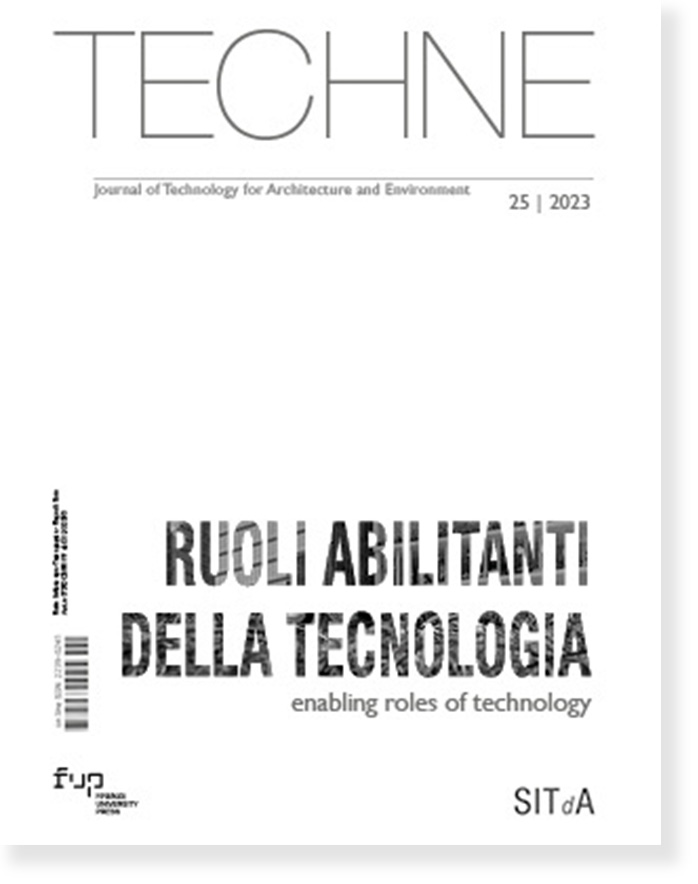Published 2023-05-30
Keywords
- Urban microclimate,
- CFD,
- ENVI-met,
- GIS,
- Software interoperability
How to Cite
Copyright (c) 2023 Matteo Trane, Guglielmo Ricciardi, Mattia Scalas, Marta Ellena

This work is licensed under a Creative Commons Attribution 4.0 International License.
Abstract
The objective of this paper is to present a methodology for the integration of a Computational Fluid Dynamics (CFD) microclimate simulation and a Geographic Information System (GIS). The first workflow involves the attribution of spatial coordinates to the point data extracted from the CFD, the implementation of an SQLite database, and the connection to the database to visualise and use information on environmental and comfort variables. The second workflow involves georeferencing the CFD raster output, attributing an ID to the point data, creating a point grid in a GIS environment, and merging these with the point data on the microclimate. For demonstration purposes, the methodology is tested on a real case study using ENVI-met and ArcGIS Pro.
Downloads
References
Oke, T. R. (1987), Boundary Layer Climates, Routledge, London.
Erell, E., Pearlmutter, D., Williamson, T. (2012), Urban Heat Island. Designing the space between buildings, Routledge, London.
Tucci, F. (2020), “Requirements, approaches, visions in the prospects for development of technological design”, in Lauria, M., Mussinelli, E., and Tucci, F. (Eds.), Producing Project, Maggioli Editore, Sant’Arcangelo di Romagna, Italy, pp. 33-42. Available at: http://www.sitda.net/biblioteca-sitda.html (Accessed on 18/07/2022).
Bruse, M., Fleer, H. (1998), “Simulating Surface-Plant-Air Interactions inside Urban Environments with a Three-Dimensional Numerical Model”, Environmental Modeling & Software, vol. 13, pp. 373-84.
Ellena, M., Breil, M., & Soriani, S. (2020), “The heat-health nexus in the urban context: A systematic literature review exploring the socio-economic vulnerabilities and built environment characteristics”, Urban Climate, vol. 34, 100676. Available at: https://doi.org/10.1016/j.uclim.2020.100676 (Accessed on 3/07/2022).
Gherri, B., Maiullari, D., Finizza, C., Maretto, M., and Naboni, E. (2021), “On the Thermal Resilience of Venetian Open Spaces”, Heritage, vol. 4, n.4, pp. 4286-4303. Available at: https://www.mdpi.com/2571-9408/4/4/236 (Accessed on 13/05/2022).
Johnson, S., Haney, J., Cairone, L., Huskey, C., Kheirbek, I. (2020), “Assessing air quality and public health benefits of New York City’s climate action plans”, Environmental science & technology, vol. 54, n. 16, pp. 9804-9813. Available at: https://doi.org/10.1021/acs.est.0c00694 (Accessed on 18/06/2022).
Lobaccaro, G., De Ridder, K., Acero, J.A., Hooyberghs, H., Lauwaet, D., Maiheu, B., Sharma, R., Govehovitch, B. (2021), “Applications of Models and Tools for Mesoscale and Microscale Thermal Analysis in Mid-Latitude Climate Regions - A Review”, Sustainability, vol. 13, 12385. Available at: https://www.mdpi.com/2071-1050/13/22/12385 (Accessed on 05/07/2022).
Pollo, R., Biolchini, E., Squillacioti, G., and Bono, R. (2020), “Designing the Healthy City: an interdisciplinary approach”, SMC, vol. 11, pp. 54-58. Available at: http://www.sustainablemediterraneanconstruction.eu/SMC/Home.html (Accessed on 06/07/2022).
Raffa, M., Reder, A., Marras, G. F., Mancini, M., Scipione, G., Santini, M., Mercogliano, P. (2021), “VHR-REA_IT Dataset: Very High-Resolution Dynamical Downscaling of ERA5 Reanalysis over Italy by COSMO-CLM”, Data, vol. 6, n. 8, 88. Available at: https://doi.org/10.3390/data6080088 (Accessed on 09/07/2022).
Zhou, H., & Dai, Z. (2021), “Green urban garden landscape simulation platform based on high-resolution image recognition technology and GIS”, Microprocessors and Microsystems, vol. 82, 103893. Available at: https://doi.org/10.1016/j.micpro.2021.103893 (Accessed on 14/08/2022).






